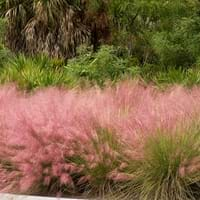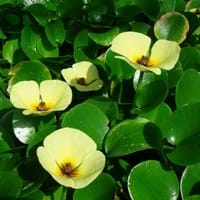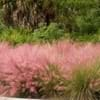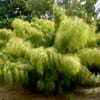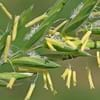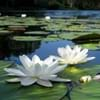Life Span
Annual
Perennial
Origin
Northeastern United States, Southeastern United States, South-Central United States, Mexico, Caribbean
South America
Types
Evergreen
Not available
Habitat
Coastal Regions, Pastures
Lakes, Ponds
USDA Hardiness Zone
5-10
9-11
AHS Heat Zone
12 - 3
11-8
Sunset Zone
4, 5, 6, 7, 8, 9, 10, 11, 12, 13, 14, 15, 16, 17, 18, 19, 20, 21, 22, 23, 24
21,22
Habit
Clump-Forming
Spreading
Flower Color
Pink
Yellow, Light Yellow, Brown
Flower Color Modifier
Bicolor
Bicolor
Fruit Color
Not Available
Non Fruiting Plant
Leaf Color in Spring
Green
Green
Leaf Color in Summer
Light Green
Green
Leaf Color in Fall
Green, Brown
Green
Leaf Color in Winter
Tan, Brown
Green
Leaf Shape
Grass like
Heart-shaped
Plant Season
Spring, Summer, Fall, Winter
Spring, Summer, Fall
Sunlight
Full Sun, Partial Sun, Partial shade
Full Sun, Partial Sun
Type of Soil
Clay, Loam, Sand
Loam, Sand
The pH of Soil
Acidic, Neutral, Alkaline
Neutral
Soil Drainage
Average
Poorly Drained
Bloom Time
Late Summer, Early Fall, Fall
Indeterminate
Tolerances
Wet Site, Drought, Salt, Soil Compaction
Shade areas, Wet Site
Where to Plant?
Ground
In Water
How to Plant?
Seedlings
By dividing rhizomes, tubers, Corms or bulbs, Offsets
Plant Maintenance
Medium
Low
Watering Requirements
Medium
Medium
In Summer
Lots of watering
Lots of watering
In Spring
Moderate
Moderate
In Winter
Average Water
Average Water
Soil pH
Acidic, Neutral, Alkaline
Neutral
Soil Type
Clay, Loam, Sand
Loam, Sand
Soil Drainage Capacity
Average
Poorly Drained
Sun Exposure
Full Sun, Partial Sun, Partial shade
Full Sun, Partial Sun
Pruning
Remove damaged leaves, Remove dead branches, Remove dead leaves
Remove damaged leaves, Remove dead branches, Remove dead flowers, Remove dead leaves
Fertilizers
All-Purpose Liquid Fertilizer
All-Purpose Liquid Fertilizer
Pests and Diseases
Red blotch
No serious insect or disease problems
Plant Tolerance
Drought
Shade areas, Wet Site
Flower Petal Number
Single
Single
Foliage Texture
Fine
Medium
Foliage Sheen
Matte
Glossy
Attracts
Butterflies
Birds, Insects
Allergy
Not Available
Not Available
Aesthetic Uses
Showy Purposes
Water gardening
Beauty Benefits
Not Available
Not Available
Environmental Uses
Air purification
Air purification
Medicinal Uses
Not Available
Not Available
Part of Plant Used
Leaves
Flowers
Other Uses
Showy Purposes
Used as Ornamental plant
Used As Indoor Plant
No
No
Used As Outdoor Plant
Yes
Yes
Garden Design
Bog Garden, Container, Feature Plant, Groundcover, Mixed Border, Rock Garden / Wall
Container, Water Gardens
Botanical Name
MUHLENBERGIA capillaris 'Regal Mist'
HYDROCLEYS nymphoides
Common Name
Pink Muhly Grass, Texas Muhly Grass
Water Poppy
In Hindi
pink muhly grass
जल पोस्ता
In German
pink muhly grass
Wasser Poppy
In French
pink muhly grass
eau Poppy
In Spanish
pink muhly grass
amapola agua
In Greek
pink muhly grass
νερό παπαρούνας
In Portuguese
pink muhly grass
água Poppy
In Polish
pink muhly grass
Woda Poppy
In Latin
pink muhly grass
Aqua Poppy
Phylum
Magnoliophyta
Magnoliophyta
Class
Liliopsida
Liliopsida
Family
Poaceae
Alismataceae
Genus
Muhlenbergia
Hydrocleys
Clade
Angiosperms, Commelinids, Monocots
Angiosperms, Monocots
Tribe
Not Available
Not Available
Subfamily
Not Available
Not Available
Number of Species
Not Available
Properties of Pink Muhly Grass and Water Poppy
Wondering what are the properties of Pink Muhly Grass and Water Poppy? We provide you with everything About Pink Muhly Grass and Water Poppy. Pink Muhly Grass doesn't have thorns and Water Poppy doesn't have thorns. Also Pink Muhly Grass does not have fragrant flowers. Pink Muhly Grass has allergic reactions like Not Available and Water Poppy has allergic reactions like Not Available. Compare all the properties and characteristics of these two plants. Find out which of these plant can be used as indoor plant. If you are interested to decorate your house and garden, find out aesthetic uses, compare them and select the plant which will beautify your surrounding. Along with beautification, try comparing medicinal and edible uses of Pink Muhly Grass and Water Poppy and you can choose the plant having best and most benefits.
Season and Care of Pink Muhly Grass and Water Poppy
Season and care of Pink Muhly Grass and Water Poppy is important to know. While considering everything about Pink Muhly Grass and Water Poppy Care, growing season is an essential factor. Pink Muhly Grass season is Spring, Summer, Fall and Winter and Water Poppy season is Spring, Summer, Fall and Winter. The type of soil for Pink Muhly Grass is Clay, Loam, Sand and for Water Poppy is Loam, Sand while the PH of soil for Pink Muhly Grass is Acidic, Neutral, Alkaline and for Water Poppy is Neutral.
Pink Muhly Grass and Water Poppy Physical Information
Pink Muhly Grass and Water Poppy physical information is very important for comparison. Pink Muhly Grass height is 60.00 cm and width 30.00 cm whereas Water Poppy height is 15.20 cm and width 60.00 cm. The color specification of Pink Muhly Grass and Water Poppy are as follows:
Pink Muhly Grass flower color: Pink
Pink Muhly Grass leaf color: Green
Water Poppy flower color: Yellow, Light Yellow and Brown
- Water Poppy leaf color: Green
Care of Pink Muhly Grass and Water Poppy
Care of Pink Muhly Grass and Water Poppy include pruning, fertilizers, watering etc. Pink Muhly Grass pruning is done Remove damaged leaves, Remove dead branches and Remove dead leaves and Water Poppy pruning is done Remove damaged leaves, Remove dead branches, Remove dead flowers and Remove dead leaves. In summer Pink Muhly Grass needs Lots of watering and in winter, it needs Average Water. Whereas, in summer Water Poppy needs Lots of watering and in winter, it needs Average Water.
